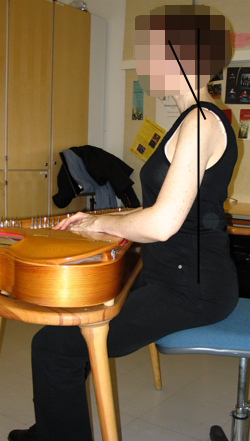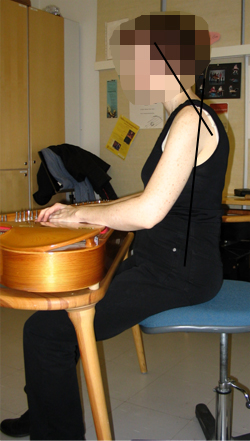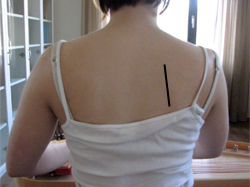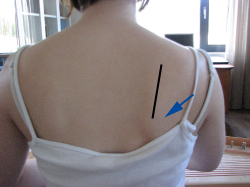Kantele - harjoittelu
Kantele
Läs först avsnittet Allmänt om ergonomi.
Mittställningen är musikerns grundställning, till vilken musikern alltid återkommer. I mittställningen upprätthålls ryggradens naturliga bågform. Ryggradens böjning är individuell, så i mittställning har alla olika ställning på ryggrad och bäcken.
Kantelespelande bör inledas med att justera spelstolen/bordet till en sådan höjd där bäckenet hålls i mittställning och sittbenen är placerade rakt nedåt mot stolen. Spelställningen bör vara aningen framåtlutande så att stödmusklerna i mellersta delen av kroppen är aktiva och stöder den annars så statiska sittställningen. Också huvudets ställning är naturligare då ryggraden lutar framåt. Spelbordet och kantelens höjd bör vara sådan att underarmarna vid spelandet böjs cirka 100-110 grader. I denna spelhöjd uppnår man en idealisk vinkel för handleden, 15 grader. Också kontrollen av skulderbladets stödmuskler är som bäst när armbågsleden är i en vinkel på cirka 100-110 grader. Om musikern sitter högre upp eller spelbordet är lågt, sträcks armarna ut och arbetar lägre ner, vilket gör att kontrollen över skulderbladets stödmuskler försvåras och handledens vinkel blir ogynnsam.
|
Bäcken och ländryggrad i mittställning, huvud och nacke i mittställning. Nedåtvändning av blicken sker med hjälp av den rörelseaxel som finns framför örat. |
Bäckenet bakåtlutande, ländryggraden alltför utsträckt, huvudet och nacken framskjutna varvid ansträngningen på området kring nacken ökar. Nedåtvändning av blicken sker med hjälp av den rörelseaxel som finns i nedre delen av nacken. |
Kontroll av skulderbladets stödmuskler möjliggör avslappning av armarna. En typisk felställning hos kantelespelare är att skulderbladet lutar framåt, avlägsnar sig från ryggraden, sjunker och ibland till och med vinklas upp från revbenen. Problemet är vanligare i den högra handen eftersom den arbetar längre ifrån kroppen och sålunda ökar belastningen på skulderbladets muskler.
|
Skulderbladet har bra stöd i bröstkorgen. |
Skulderbladen stöds dåligt mot bröstkorgen, och särskilt det högra skulderbladet lutar framåt, vinklas upp från bröstkorgen och skulderbladets nedre kant vrids mot ryggraden. |
Felställning av skulderbladen ökar belastningen på överarmen och armen samt musklerna kring nack- och axelpartiet. När skulderbladet får stöd känns handen lätt och avslappnad.
För fingrarnas funktion är den idealiska vinkeln för handleden 15 grader utsträckt och 15 lutande mot lillfingret. Ställningen möjliggör en god funktion hos handflatans muskler och bevarar sålunda de tvärgående bågarna i handen. En naturlig handställning möjliggör rätt slags beröring av kantelens känsliga strängar. Om handflatan saknar stöd ser man ofta överrörliga fingerleder med dålig hållning, vilket försämrar fingrarnas beröring vilket igen hörs på ljudet.
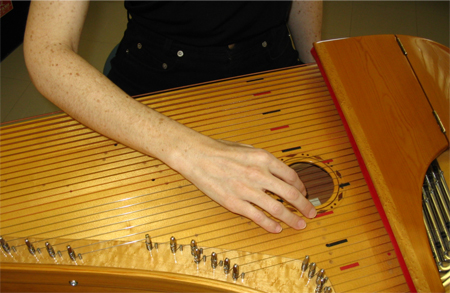
Handleden i mittställning, knogarna bildar en jämn båge och fingrarna hålls böjda. I denna ställning är kontrollen av fingrarna och beröringen av strängarna som bäst.
Det är också viktigt att man bevarar tummens bågform. Tummens mellanled stöds av musklerna vid tummens rot (nära handleden). Bågform i handflata och fingrar vid spelandet vittnar om att händernas stödmuskler fungerar väl och att fingermusklerna som löper över handleden inte tvingas arbeta alltför hårt.

